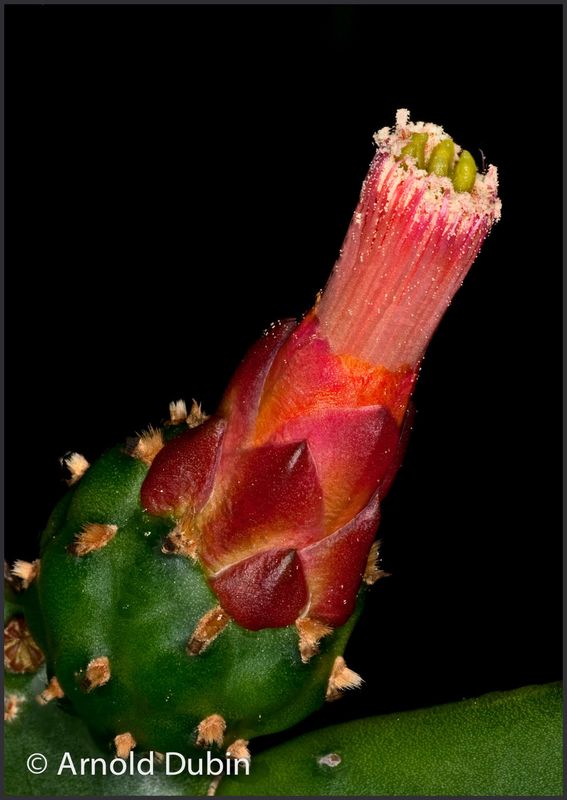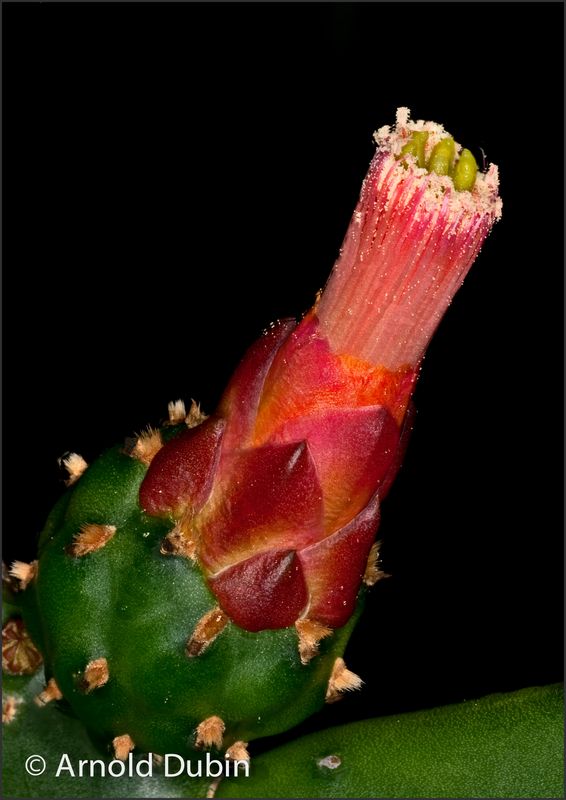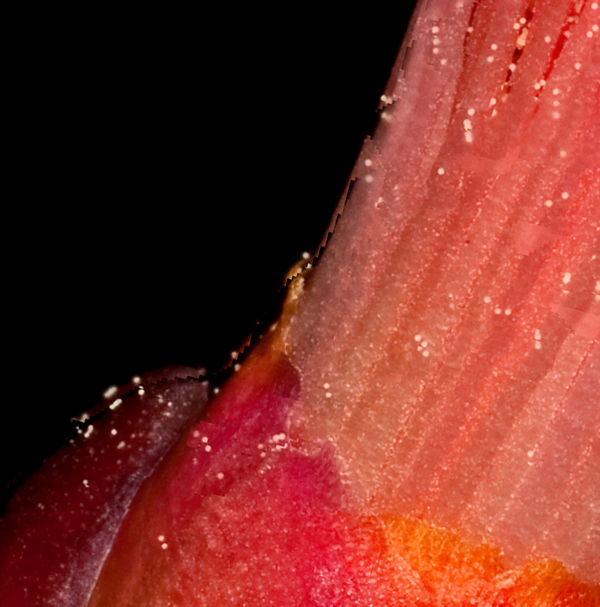3 Photo Stack Macro Cactus Flower - Need Your Feedback
Feb 7, 2012 07:05:50 #
I used a Nikon D300S with Nikkor 60 mm f2.8 Micro lens and a Sigma Ring Flash EM-140 DG to take 3 photos of this Cactus focus at 3 different area. The lens was at 1:1, ISO 160, Speed 1/320, and f-stop at f-22. I used Photoshop CS4 to stack these photos, and make further enhancements on this final image. I noticed that at the top of the flower I had to remove part of it because it showed multiple levels of the tiny yellow tip of it. I know there are other software products out to do this stacking. I would like people to provide me back with their honest critiques. Thanks, Arnold
Cactus Flower That I Took 3 Photos Of for Improve Sharpness

Feb 7, 2012 14:20:04 #
This is an excellent method to extend DOF on table-top macro subjects. Obviously, this is not a field technique.
Since you only posted a thumbnail, I cannot enlarge to see fine detail, like pollen. Next time, or even now, add a new image, and check the box labeled (store original) so we can enlarge photo.
I will assume that this is an indoor, "table-top" scenario, where you have controlled all variables, like background. Is it possible to place a bit of color to background, so it is not jet back? Something like a medium blue cloth to contrast all subject colors. It won't be in focus, and brightness can be controlled by how close or far away it is placed. I want to see a crisp outline of plant on left side. Now it just fades to black.
I could stand to see a bit more cropping at top and right side, to eliminate extra background.
Nicely done. A useful winter activity.
Since you only posted a thumbnail, I cannot enlarge to see fine detail, like pollen. Next time, or even now, add a new image, and check the box labeled (store original) so we can enlarge photo.
I will assume that this is an indoor, "table-top" scenario, where you have controlled all variables, like background. Is it possible to place a bit of color to background, so it is not jet back? Something like a medium blue cloth to contrast all subject colors. It won't be in focus, and brightness can be controlled by how close or far away it is placed. I want to see a crisp outline of plant on left side. Now it just fades to black.
I could stand to see a bit more cropping at top and right side, to eliminate extra background.
Nicely done. A useful winter activity.
Feb 7, 2012 15:41:15 #
Nikonian72, Actually, this series of photos was taken outside of a house in our local area. It was a cloudy day, and virtually no wind. As I mentioned this was taken with a Sigma Ring Flash. I respect your comments and feedback, so give me your honest opinion of it, and what I need to do to improve it. Thanks, Arnold
Nikonian72 wrote:
This is an excellent method to extend DOF on table... (show quote)
Large Version of the Stacked Photo

Feb 7, 2012 17:06:24 #
Adubin wrote:
Actually, this series of photos was taken outside of a house in our local area. It was a cloudy day, and virtually no wind. As I mentioned this was taken with a Sigma Ring Flash.
Excellent results for outdoor multi-plane photographs. My compliments.
In the future, it may still possible to provide a colored background for edge-definition purposes.
Using your high-rez repost, I can see a little area of duplication, possibly from slight subject movement, or from position change after re-focusing. Several items are duplicated, like petal edge, highlights, and (pollen?) spots.

Feb 7, 2012 17:13:42 #
Adubin wrote:
I used a Nikon D300S with Nikkor 60 mm f2.8 Micro ... (show quote)
Arnold. First of all nice job. I have a minor suggestion related to lens performance: Pretty much all lenses suffer from diffraction, particularly when the lens is stopped down. Conversely, almost all lenses "control" diffraction best at F8 or in the middle range. Try shooting more images to stack at a midrange f stop. I realize this may not be possible in an outdoor setting where wind becomes a factor.
Feb 7, 2012 17:24:40 #
ShooterOR wrote:
Pretty much all lenses suffer from (aperture) diffraction, particularly when the lens is stopped down. Conversely, almost all lenses "control" diffraction best at f/8 or in the middle range. Try shooting more images to stack at a midrange f/stop. I realize this may not be possible in an outdoor setting where wind becomes a factor.
Good point. I tend to shoot at f/22 for max DOF in single images when photo stacking is absolutely not possible.
Narrow-DOF, multiple image capture is best controlled indoors, on a table-top, with a rail-advance set-up, where camera and lens are shooting straight down, like an over-sized microscope. Way beyond my experience.
Feb 7, 2012 17:28:24 #
Nikonian72 wrote:
quote=ShooterOR Pretty much all lenses suffer fro... (show quote)
I have a macro rail which I sometimes use. I purchased it more for the enhanced focusing ability with 1:1 magnification and very small DOF. Just the action of "locking down" would alter the focus. Used to drive me nuts. I'll find some examples to share, but I'm not where I'm able to do so now.
Feb 7, 2012 17:55:47 #
ShooterOR wrote:
I have a macro rail which I sometimes use. I purchased it more for the enhanced focusing ability with 1:1 magnification and very small DOF. Just the action of "locking down" would alter the focus. Used to drive me nuts. I'll find some examples to share, but I'm not where I'm able to do so now.
I understand that a motor-driven rail can eliminate the focus shift, due no lock-down between photos.
Feb 7, 2012 17:58:52 #
Nikonian72 wrote:
I understand that a motor-driven rail can eliminate the focus shift, due no lock-down between photos.
.ShooterOR wrote:
I have a macro rail which I sometimes use. I purchased it more for the enhanced focusing ability with 1:1 magnification and very small DOF. Just the action of "locking down" would alter the focus. Used to drive me nuts. I'll find some examples to share, but I'm not where I'm able to do so now.
I understand that a motor-driven rail can eliminate the focus shift, due no lock-down between photos.
That's probably the best way....
Feb 7, 2012 18:01:27 #
Nikonian72 wrote:
quote=Adubin Actually, this series of photos was ... (show quote)
I noticed this in the original: mostly the three repeating bright spots (pollen?). Some software can register these pretty well. I believe in Photoshop, you can incremently budge the layer until it aligns--but I'm no PS expert.
Feb 8, 2012 04:25:58 #
Nikonian72, Thanks for your feedback. I have 2 questions for you.
1. If I use a different program, will it do a better job than PS CS4?
2. Should I consider buying a macro rail to improve my focusing capability?
Arnold
1. If I use a different program, will it do a better job than PS CS4?
2. Should I consider buying a macro rail to improve my focusing capability?
Arnold
Nikonian72 wrote:
quote=Adubin Actually, this series of photos was ... (show quote)
Feb 8, 2012 04:28:01 #
ShooterOR, Thanks for your recommendation. I will try it next time I have the opportunity. Arnold
ShooterOR wrote:
quote=Adubin I used a Nikon D300S with Nikkor 60 ... (show quote)
Feb 8, 2012 04:33:20 #
ShooterOR, I tried to masked out some of the duplicate images but didn't do a very good job. Arnold
ShooterOR wrote:
quote=Nikonian72 quote=Adubin Actually, this ser... (show quote)
Feb 8, 2012 09:47:47 #
Adubin wrote:
ShooterOR, I tried to masked out some of the dupli... (show quote)
I think you are on the right track. When I first became aware of this procedure, I was more interested in it from a landscape perspective--rather than the more common use for macro--primarily because of diffraction when stopping down lenses as well as extending DOF. Although we are all primarily interested "how it looks", slrgear.com does an excellent job, IMO, in graphing diffraction. I raise the use of stacking of landscapes for this reason: stacking in macro often requires a high number of images, stacking in landscape would require fewer images. The critical aspect is to overlap DOF in each subsequent "slice." Anyway, enough rambling-- and keep submitting examples. Unfortunately, I don't have as much time (for photography) as I wish I had.
Feb 8, 2012 14:24:36 #
Adubin wrote:
1. If I use a different program, will it do a better job than PS CS4?
I do not use PhotoShop, and have not used a stacking program for quite some time. I cannot render a valid opinion.
Adubin wrote:
2. Should I consider buying a macro rail to improve my focusing capability?
I have used a focusing rail, but have never owned one. I suggest finding a local macro-photographer already using a rail. Trial use is a good teacher.
I also suggest that you continue corresponding with ShooterOR, who has superior experience with rails.
If you want to reply, then register here. Registration is free and your account is created instantly, so you can post right away.

